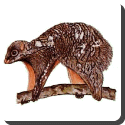 Colugo — Colugos are arboreal gliding mammals found in South-east Asia. There are just two extant species, each in its own genus, which make up the entire family Cynocephalidae and order Dermoptera. Though they are the most capable of all mammal gliders, they cannot actually fly. They are also known as cobegos or flying lemurs (misleadingly, since they are not lemurs and cannot fly).
Colugo — Colugos are arboreal gliding mammals found in South-east Asia. There are just two extant species, each in its own genus, which make up the entire family Cynocephalidae and order Dermoptera. Though they are the most capable of all mammal gliders, they cannot actually fly. They are also known as cobegos or flying lemurs (misleadingly, since they are not lemurs and cannot fly).
Colugos are fairly large for a tree-dwelling mammal: at about 35 to 40 cm (14 to 16 in) in length and 1 or 2 kilograms (2 or 4 pounds) in weight, they are comparable to a medium-sized possum or a very large squirrel. They have moderately long, slender limbs of equal length front and rear, a medium-length tail, and a relatively light build. The head is small, with large, front-focused eyes for excellent binocular vision, and small, rounded ears. When born, the Colugo weighs only about 35g (1.2oz) and do not reach adult size for 2–3 years.
Their most distinctive feature, however, is the membrane of skin that extends between their limbs and gives them the ability to glide long distances between trees. Of all the gliding mammals, the colugos have the most extensive adaptation to flight. Their gliding membrane, or patagium, is as large as is geometrically possible: it runs from the shoulder blades to the fore-paw, from the tip of the rear-most finger to the tip of the toes, and from the hind legs to the tip of the tail; unlike in other known gliding mammals even the spaces between the fingers and toes are webbed to increase the total surface area, as in the wings of bats. As a result, colugos were traditionally considered being close to the ancestors of bats, but are now usually seen as the closest living relatives to primates.
They are surprisingly clumsy climbers. Lacking opposable thumbs and not being especially strong, they proceed upwards in a series of slow hops, gripping onto the bark of trees with their small, sharp claws. They are as comfortable hanging underneath a branch as sitting on top of it. In the air, however, they are very capable, and can glide as far as 70 metres (230 feet) from one tree to another with minimal loss of height.
Colugos are shy, nocturnal, and restricted to the tropical rainforests of Southeast Asia. In consequence, remarkably little is known about their habits, although they are believed to be generally solitary, except for mothers nursing young. They are certainly herbivores, and are thought to eat mostly leaves, shoots, flowers and sap, and probably fruit as well. They have well-developed stomachs and long intestines, capable of extracting nutriment from leaves.
The incisor teeth of colugos are highly distinctive; they are comb-like in shape, with up to twenty tines on each tooth. The second upper incisors have two roots, another unique feature among mammals. The function of these adaptations is not currently known.
 Kids Portal For Parents India Kids Network
Kids Portal For Parents India Kids Network






